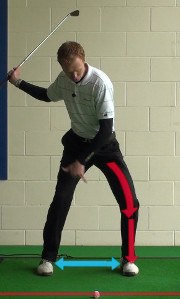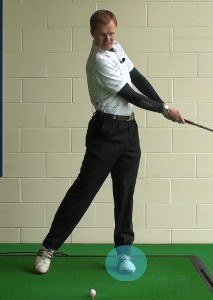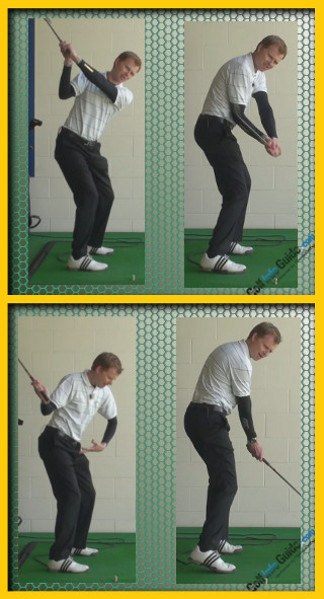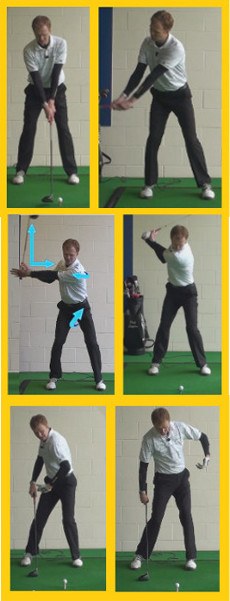
There's a photo of Sam Snead, well past age 60, kicking one leg over his head. Such remarkable flexibility and athleticism made Snead's golf swing the most envied of his era.
Snead's era, in fact, lasted longer than any other golfer's. From 1936-65, the charming rascal from Virginia won 82 PGA Tour events, a record that stands today. His final victory, at the Greater Greensboro Open, came at age 52, yet another all-time mark.
As a contemporary of Ben Hogan and Byron Nelson, both also born in 1912, Snead played a starring role in some of golf's most legendary battles. Those lucky enough to have seen Snead play still marvel at his length off the tee and ability to shape shots at will.
It's that syrupy swing, though, for which “Slammin' Sammy” is best remembered.
Snead's signature: Snead's left knee moved laterally, and farther from his right knee, as he began the downswing. This caused his body to lower into a position known as the “Snead Squat.”
Who else does it: The majority of modern pros “sit down” as they approach the ball. Tiger Woods and Rory McIlroy are among the notable examples. In fact, Snead himself acknowledged the similarities, saying, “When I got in that position, like Tiger Woods, I could throw a little bit more heat to it.”
As with most players of the time, Snead turned his left knee sharply inward on the backswing as part of a big hip turn. The left knee initiated his downswing by sliding toward the target, creating a wide gap between his knees. In still photos, Snead appeared to be squatting down as he approached the ball.

Why it worked for Snead: Like Hogan's bowed or flat left wrist, Snead's dip is actually quite common among top golfers. It was a major source of his power as well. In essence, Snead used the ground for leverage. Think about jumping to rebound a basketball: You bend at the knees, then explode upward, right? The concept is similar.
As for Snead's knee separation, some believe his lateral movement and lower-body rotation were necessary to prevent him from hitting the ball to the right, as he tended to set up with a closed stance and “pull” the ball back on line.
How it can work for you: As with many of the topics in our Signature Moves series, it's not wise to consciously emulate Snead's left knee sequence. What's important is to start the downswing at ground level, specifically with the left heel.
Upon reaching the top of your backswing, press down with the left heel. (If it's off the ground, simply place it back down.) This triggers the knee and hip to rotate, bringing the torso, shoulders, arms and, finally, the club with them.
As for the sitting or squatting motion, this will happen naturally as long as your knees are flexed and you begin the downswing properly.

What You Can Learn from Sam Snead's Knee Separation on the Downswing
Sam Snead is one of the greatest golfers of all time. He owns 82 career PGA Tour wins, the most by any golfer in history. All told, he recorded 165 wins in his professional career, including seven major championship titles. By any measure, Snead is a legend in the game of golf.
Many consider Sam Snead to have had a perfect golf swing – or, at least, as close as one can come to a perfect golf swing. Despite standing less than six feet tall, Snead was a powerful player, and one of the longest hitters of his era. Although Snead passed away more than a decade ago, many golfers still study his impressive swing technique in an effort to improve their own game. One particular element of Snead's swing that draws attention is his knee separation in the downswing. This move is somewhat unique, but it may have been largely responsible for the impressive power he was able to generate.
For most right handed golfers, the downswing begins with the right knee moving in toward the left. This starts the rotation of the lower body toward the target, and enables the club to drop into the 'slot' for the rest of the downswing. There is nothing wrong with using this traditional method. However, it is worth taking note of the alternative method used by Snead. Instead of the right knee moving in toward the left, it actually stays mostly in place while he squats down into the swing. Both knees add flex as the downswing begins, and the left knee starts to move toward the target. The result is a widening gap between the knees, and a squatting position that will be used to create speed at the bottom of the swing.
When Snead brings the club down into the ball, that squatting position is eliminated as he straightens up on both legs. The right and left leg simultaneously give up their flex, forcing Snead into a taller position. As a result, the club whips through the hitting area with tremendous force. While it is not out of the 'textbook' for golf swing technique, it is obvious that Snead was able to use this motion to take him to the top of the golf world.
So why don't more golfers copy this technique? Quite simply, it just isn't that easy to replicate. There is a great deal of timing required in order to square the club face at impact while simultaneously standing up taller during the downswing. There is incredible potential in this kind of swing technique, but the execution of it time after time requires talent and significant practice time. With that said, there are things you can learn from observing the knee separation in the downswing that Sam Snead used, even if you don't fully replicate his moves in your own game.
All of the instruction below is based on a right handed golfer. If you play left handed, please reverse the instructions as necessary.

The Importance of Stability
Stability is a word that you will hear a lot of golf teachers use when talking about the downswing. You want your body to be in a stable position so you can fully release the club without falling off balance. Many amateur players lose stability right from the top of the swing – making it nearly impossible to maximize their potential swing speed. One of the main reasons that Sam Snead was able to extract so much power from his swing was the fact that his technique provided him with plenty of stability from the top of the swing all the way through impact.
By avoiding any lateral movement with the right knee early in the downswing, Snead was able to give himself a strong base on which to swing. If his knees were to come close together in the downswing, as is the case with so many other player's swings, he would have lost some of his ability to balance while swinging the club. It is helpful to have a wide stance with your feet during the swing, but that stance alone won't keep you on balance. The position of your legs is even more important than the position of your feet, and Snead's swing is a perfect demonstration of that fact. When you position your legs in such a way that your hips and torso are free to turn aggressively toward the target, you will be able to truly turn the club loose for maximum speed.
If you would like to work on the stability of your own swing, try completing the simple drill below.
- To start, you will need a golf club (any club) and a basketball or soccer ball. You won't be hitting any actual shots during this drill, so it is not necessary to be at the driving range. If you decide to do the drill at home, you will need to make sure you are in an area with enough space to safely make some practice swings.
- Take your stance as if you are going to hit a regular golf shot. While taking your stance, you should be holding your golf club in your left hand, and your ball of choice in your right hand.
- Once your feet are in position, take the ball and place it between your knees (or slightly higher). Position the ball so you can use your legs to 'trap' it in place. When you take your hand away, you should be able to hold the ball in place simply by squeezing your legs together slightly.
- While keeping the ball in place, put both hands on the golf club and complete your address position.
- Start your backswing, moving slowly at first. You should be able to arrive at the top of your swing while continuing to hold the ball in place.
- As you transition from backswing to downswing, try allowing the ball to drop by squatting further into your stance. As you squat, there will be more room between your two legs, and the ball should fall to the ground.
- Continue through the rest of the swing to a balanced finish. Swing slowly at first to make sure you aren't going to hit the ball after it bounces off the ground.
When executed correctly, this drill should lead you nicely toward imitating the knee separation that Snead used in his swing. As you are making practice swings, you might notice that the motion required to complete the drill successfully feels a little bit exaggerated. That's okay. The exact motion that you use during the drill doesn't need to be replicated in your swing. The goal is to learn the feeling of squatting slightly into your stance to build a stable platform for the downswing action.
After completing a few repetitions with this drill, go ahead and make some practice swings (or hit some balls, if you are at the range) without the ball between your knees. Think about using what you have learned from the drill during these swings, but don't be too concerned with specific swing positions. As long as your knees are maintaining separation during the early parts of the downswing, you will have taken a big step forward with your overall swing technique.

Explosion through Impact
You may or may not be able to imitate the knee separation that Snead used in his downswing. To find out if this unique move will help your swing, you will need to work on the drill outlined above and then try hitting some shots. However, whether you use the knees separation technique or not, you can still gain a valuable lesson from the way Snead exploded through impact to impart a serious blow onto the back of the golf ball.
As he approached impact, Snead stood up out of his stance in order to expel every bit of energy that he could find. Thanks to impressive rhythm and timing, he was able to control the golf ball while doing this more often than not. Most golfers, unfortunately, don't have the same innate sense of timing. More likely, your own swing will include more rotation than vertical movement when you arrive at impact. Even still, you can learn from the way Snead turned the club loose and trusted his mechanics to send the ball straight at the target.
Trust is a vital aspect of playing good golf, and it is easy to tell that Snead had plenty of trust and belief in his game. The opposite is true for most amateur golfers. The average golfer swings the club into the ball with some combination of fear and uncertainty. When you have negative thoughts rolling around in the back of your mind, it is far more likely that you will hit a poor shot. Total commitment to your swing is required if you are going to execute to the best of your ability.
In order to build confidence and learn how to turn the club loose through impact on each swing, try using the tips below –
- Make smart decisions. The best way to add confidence to your swing is simply to make smart decisions as you move around the course. When you decide to take on a shot that is too challenging for your current skill level, your mind will naturally be doubtful prior to making the swing. To solve this problem, only take on shots that you are sure you can handle. If, for example, you have 200 yards to carry a water hazard in front of you, consider laying up if that distance is stretching your limits. By only attempting shots you truly believe you can handle, many of your doubts will quickly slip away.
- Find Comfort in Routine. Preparing the same exact way for each and every shot you hit (driving range included) is a great way to grow your confidence. Your pre-shot routine can become a brief period of time prior to each shot that you can use to gather your thoughts and provide yourself with some encouragement. By using the same routine on the range as you use on the course, you can create a continuity that will give you confidence to make your best swings, even under pressure.
- Hit More Balls. Most amateur golfers would rather play a round of golf than spend a couple hours hitting balls on the range. While that is understandable, it is also important to recognize the vital role that the practice range can play in making you a better golfer. It would take you several rounds of golf to amass the number of swings that you can fit into a single practice session. There is no substitute for repetitions when trying to improve at any skill, and that certainly applies to golf. Spend more time on the practice range and you will believe in yourself more when the time comes to test yourself on the course.
You don't need to know anything about Sam Snead to know that he had confidence in his golf swing. When you look at the way he released the club through impact as he used his legs to generate incredible speed, it is easy to tell that he fully believed in what he was doing. No matter what your individual swing mechanics happen to look like, you can certainly benefit from finding that same kind of belief in your own game.

Dealing with a Range of Course Conditions
As you already know, golf is not frequently played on flat ground. You might draw a flat lie from time to time, but most of your shots are going to be hit from some degree of slope. The ability to handle various slopes as you move around the course is what is going to separate you from the competition. You want to be able to make consistent swings from flat lies, but it is even more important to be able to adapt your swing to the unique stance and lie that each new shot presents.
This is another reason the stable platform created in Mr. Snead's swing is so important. When he squats down into his stance, he is creating a base that is going to stabilize his swing no matter what is going on below his feet. Whether playing from flat ground or some kind of sloped lie, Sam Snead was able to dynamically swing the club down into the ball. Below are three ways that you can benefit from using knee separation to help you deal with uneven lies on the course.
- Solid strike. The hardest part of playing from an uneven lie is simply making solid contact with the ball. It is easy to catch the ball heavy or thin depending on the lie you are playing from, and that is especially true if you are off balance in the downswing. Using knee separation will help you to prevent your body from being pulled off balance from the slope. When you keep your balance, your upper body will remain correctly positioned over the ball, and you will be able to make solid contact. It is a simple concept, but difficult to execute. By adding some knee separation to your downswing, you may find that uneven lies aren't nearly as scary as they once were.
- Maintaining distance. Among amateur golfers, those who are able to make solid contact from an uneven lie usually lose plenty of distance in the process. They are required to modify their swing in order to deal with the stance, and therefore they can't generate the same kind of club head speed that they are able to create on a flat lie. That won't be a problem when you use the Snead knee separation. Your lower body will be able to deal with the uneven ground so that your upper body is free to swing the club aggressively through impact. Even hitting your irons an extra five or ten yards from an uneven fairway lie can make a big difference, so don't overlook the importance of this skill.
- Keep your footing. It is easy to slip when playing from an uneven lie – especially when you are hitting from an upslope that is running down away from the target. When your left foot is above your right, you run the risk of having your right foot slip out from under you during the transition. That problem can be minimized by holding your knees apart during the downswing. Since your right knee won't be collapsing in toward your left, it will still be stacked on top of your right foot. This means that more of your weight will be directly over your right foot, and your shoe will likely maintain plenty of traction on the ground.
A quality golfer is one who can play good shots not only from good lies, but from challenging lies as well. When you find your ball resting on an uneven lie, it is nice to know that the knee separation you have built into your golf swing will aid you in hitting a solid shot directly at your target.

The Effect of Knee Separation on the Rest of Your Swing
All of the parts of the golf swing are connected. If you work on making a change to one part of your swing, you have to be careful to watch how it will affect the rest of your swing mechanics. For example, changing your address position can change your takeaway, so you need to consider them both when making an adjustment to your swing.
In this case, you should understand what other parts of the swing to keep an eye on while you try to add knee separation to your downswing. As you practice, make sure the following three elements remain in place within your swing –
- Tempo. If balance is the most important element of the golf swing, tempo comes in a close second. When you have good tempo, you are able to cover up for a lot of other technical swing mistakes. It is specifically important to have good tempo when you are trying to add some knee separation to your downswing. A good tempo will provide you with the necessary time to squat into your downswing and then rebound again prior to impact. Many amateur golfers have a bad habit of losing their tempo and cutting the backswing short, which could lead to a rushed downswing and a poor result.
- Good posture. Before your swing even begins, you need to check to be sure you are in a good, athletic posture. Without a proper address position, it will be nearly impossible to execute the knee separation that is seen in Snead's swing. If you aren't confident in your address position at this time, go back and work on that fundamental before you consider focusing your efforts on downswing knees separation.
- Eyes down on the ball. When trying to use your legs to explode through the shot, there is always the danger of looking up early. By taking your eyes off the ball before impact, you will be running the risk of making poor contact. No matter how hard you are swinging, maintain eye contact with the ball until it has been struck. Having the discipline to control your eye movement during the swing will go a long way toward keeping your swing mechanics in order.
It should be obviously that you may have trouble exactly replicating the legendary golf swing of Sam Snead – after all, he is one of the best players in the history of the game. That doesn't mean, however, that you can't learn from his impressive example. Specifically, take note of the knee separation that he used in the downswing to simultaneously create power and stability. You don't have to use this move to the same degree as Mr. Snead, but even a slight separation of the knees during the early stages of your downswing can do wonders for the quality of your ball striking.






